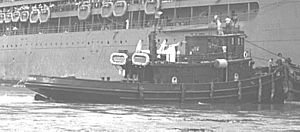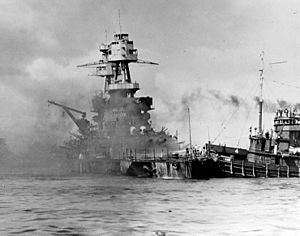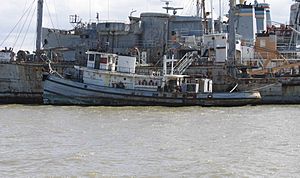Hoga (YT-146) facts for kids

Hoga at Pearl Harbor in 1942
|
|
| History | |
|---|---|
| Awarded | 1 June 1940 |
| Builder | Consolidated Shipbuilding Corporation |
| Laid down | 25 July 1940 |
| Launched | 31 December 1940 |
| Acquired | 1 May 1941 |
| In service | 22 May 1941 |
| Out of service | July 1996 |
| Renamed |
|
| Reclassified |
|
| Stricken | 12 July 1996 |
| Status | Museum ship |
| General characteristics | |
| Class and type | Woban-class district harbor tug |
| Displacement | 325 tons |
| Length | 100 ft (30 m) |
| Beam | 25 ft (7.6 m) |
| Draft | 9 ft 7 in (2.92 m) |
|
USS Hoga (City of Oakland) (Tug)
|
|
| Built | 1941 |
| Architect | Consolidated Shipbuilding Corp. |
| NRHP reference No. | 89001429 |
| Significant dates | |
| Added to NRHP | 30 June 1989 |
| Designated NHL | 30 June 1989 |
Hoga (YT-146/YTB-146/YTM-146) was a brave United States Navy tugboat. Its name, Hoga, comes from a Sioux Indian word meaning "fish." This special tugboat became famous for its heroic actions during the Attack on Pearl Harbor in World War II. After the war, Hoga was renamed Port of Oakland and then City of Oakland. It served as a fireboat in Oakland, California, protecting the city's busy harbor. Today, Hoga is a museum ship, helping people learn about its important history.
Hoga was built by the Consolidated Shipbuilding Corporation in Morris Heights, New York. Its construction began on July 25, 1940. The tugboat was launched on December 31, 1940, and was named Hoga (YT-146). It officially started service on May 22, 1941, in Norfolk, Virginia. Hoga then traveled through the Panama Canal to reach its new home at Pearl Harbor in Hawaii. At Pearl Harbor, Hoga helped move cargo ships and assist larger vessels. It also carried important firefighting equipment.
Contents
Hoga's Heroic Actions at Pearl Harbor
On the morning of December 7, 1941, Japanese forces launched a surprise attack on Pearl Harbor. Hoga was docked near other service boats when the attack began.
Responding to the Attack
Within ten minutes of the first bombs, Hoga was already moving. It quickly steamed into the harbor, rescuing two sailors from the water. Then, it headed straight for the burning battleships. One of the most damaged ships was the USS Arizona. Next to Arizona was the repair ship USS Vestal. Hoga helped pull Vestal away from the burning Arizona at 8:30 AM.
Saving the USS Nevada
After helping Vestal, Hoga went to assist the minelayer USS Oglala. As Hoga reached Oglala, the battleship USS Nevada began to move. Nevada had been hit by a torpedo and bombs. Its crew was trying to escape to the open sea. The Japanese planes then focused their attack on Nevada, hoping to sink it in the narrow harbor entrance and trap other ships.
Nevada was hit by many bombs and began to sink. To prevent it from blocking the channel, Nevada needed to be moved. Admiral William R. Furlong saw the danger and sent Hoga and another tugboat to help. Hoga worked hard to push the sinking Nevada towards Hospital Point. This helped Nevada settle safely in soft sand by 10:45 AM.
Fighting Fires and Receiving Praise
After helping Nevada, Hoga returned to the main battle area. It fought fires on the battleships USS Maryland and USS Tennessee. Finally, Hoga spent many hours fighting the massive fire on the USS Arizona. The crew worked tirelessly from Sunday afternoon until Tuesday afternoon, for 72 hours straight!
Hoga and its crew continued to work for the rest of the week. They patrolled the harbor, helped remove bodies, and searched for enemy submarines. Their bravery did not go unnoticed. In February 1942, Admiral Chester W. Nimitz, a very important Navy leader, praised Hoga's captain and crew. He said they showed "efficient action and disregard of your own personal safety" during the attack.
After the attack, Hoga helped clean up the harbor. It also assisted in salvaging (recovering) damaged ships. This work continued throughout World War II. Hoga played a vital role in keeping Pearl Harbor ready for action. In 1948, Hoga was loaned to the Port of Oakland to become a fireboat.
Serving as a Fireboat in Oakland
Oakland, California, is a very busy port. It needed a strong fireboat to protect its waterfront. In April 1948, the Navy loaned Hoga to Oakland. The city made changes to Hoga to make its water pumps even stronger. It could now pump up to 10,000 gallons of water per minute!
In July 1948, the fireboat, now called Port of Oakland, began its new job. Later, its name was changed again to City of Oakland. It was docked at the foot of Broadway, ready to respond quickly to any emergency. Just one day after it officially started service, Port of Oakland was called to help fight a fire on a freighter called Hawaiian Rancher.
For 40 years, Hoga served Oakland. It fought many ship fires and waterfront blazes. It also rescued people from the water. In 1980, President Jimmy Carter even took a short tour of the port on the City of Oakland! The fireboat was moved to a new dock at Jack London Square in 1982. One of its last big missions was fighting a fire on the tanker SS Puerto Rican in 1984.
Hoga Becomes a Museum Ship

In 1989, Hoga was recognized as a National Historic Landmark. This means it is a very important historical site.
The City of Oakland returned Hoga to the Navy in 1994. It was then stored in the Suisun Bay Reserve Fleet with other old ships. In 2005, the Navy decided to donate Hoga to the City of North Little Rock, Arkansas. Hoga stayed in California until 2012. It then went to a drydock to be prepared for its long journey to Arkansas.
Hoga finally arrived at the Arkansas Inland Maritime Museum on November 23, 2015. After some restoration work, it will be open for public tours. At the museum, Hoga is displayed alongside the submarine USS Razorback. Hoga represents the beginning of World War II at Pearl Harbor. The Razorback was present in Tokyo Bay when Japan surrendered, marking the end of the war. Together, these ships tell an important story of the war.



